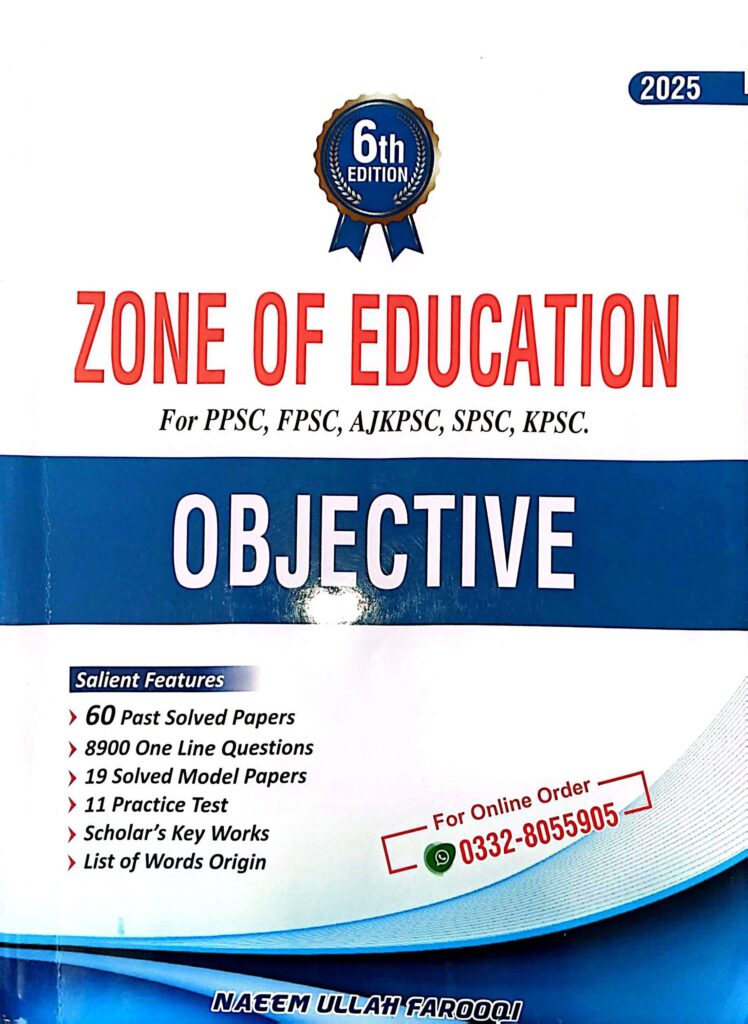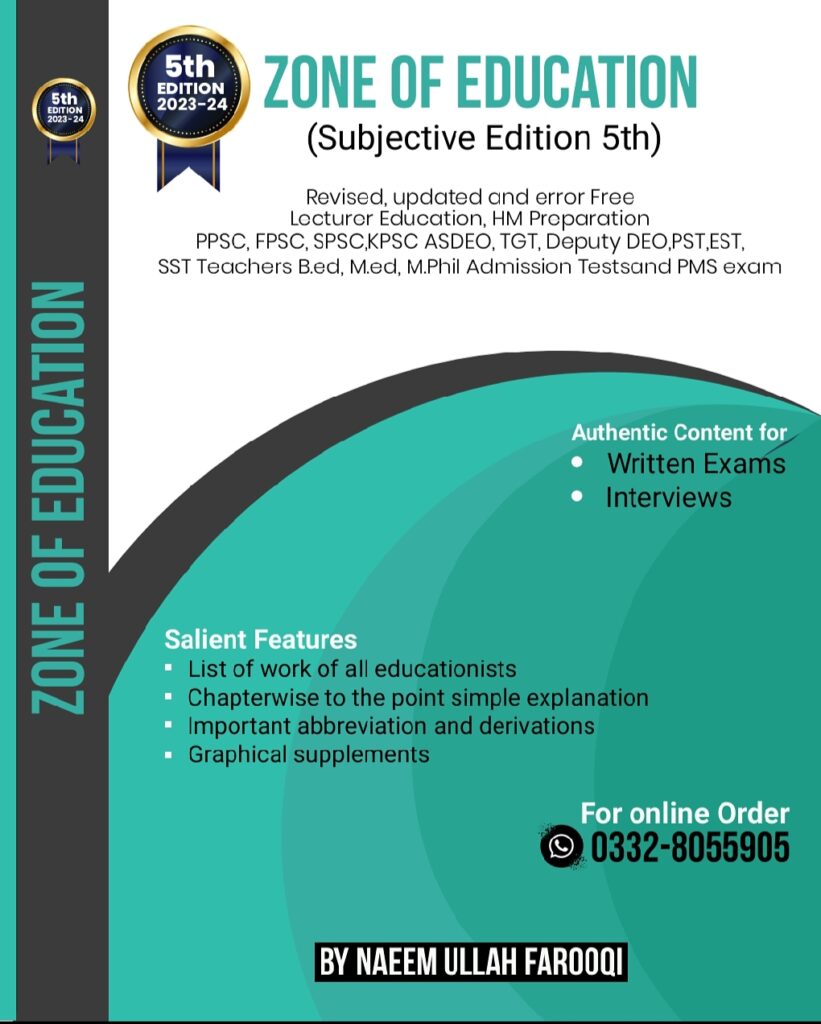History/Perspective 0f Education.
.131. The Islamic system of education recommends that along with learning National language, the following language should also be learnt:
(a) English
(b) Arabic
(c) Persian
(d) French
Answer: (b)
132. Like Ibn-e-Sina, Imam Ghazali believes that education of child should begin with:
(a) Playing
(b) Prayer
(c) Quran
(d) Writing
Answer: (c)
133. The core of curriculum for early Muslims was:
(a) Quran
(b) Hadith
(c) Fiqah
(d) Islamic History
Answer: (a)
134. Islamic education considers that Quran and Sunnah offer man:
(a) A complete code of life
(b) A perfect code of life
(c) A preferred code of life
(d) A proper code of life
Answer: (b)
135. The attitude of the Holy Prophet (SAW) in administration theory and practice was:
(a) Authoritarian
(b) Humanitarian
(c) Aristocratic
(d) Autocratic
Answer: (b)
136. Islamic education should aim at the balanced growth of total personality of man through training of his:
(a) Spirit and intellect
(b) Rational self
(c) Feeling and bodily senses
(d) All of the above
Answer: (d)
137. The Holy Prophet (SAW) pointed out that it would be the end of this world if the offices were assigned to people:
(a) Illiterate
(b) Unworthy
(c) Poor
(d) Rich
Answer: (a
138. It is defined that Faith, Religion, Language, Law, Arts, Rituals and Traits are supposed to be part of:
(a) Social setting
(b) Culture
(c) Religion
(d) Education system
Answer: (b)
139. Good relationship emphasis on the control of:
(a) Anger
(b) Disobedience
(c) Anxiety
(d) Rigidity
Answer: (a)
140. The religion provides the foundation for:
(a) Discipline
(b) Unity
(c) Faith
(d) All of the above
Answer: (d)
141. The Holy Prophet (SAW) delivered his instruction to women to a week:
(a) Once
(b) Twice
(c) Thrice
(d) Four times
Answer: (a)
142. In early stage of Islam, classes of teachers were:
(a) Two
(b) Three
(c) Four
(d) Five
Answer: (a)
143. The certificate of professional qualification was known as:
(a) Sard
(b) Sand
(c) Ijaza
(d) Izaz
Answer: (c)
144. Ibne-Khadum was thinker, historian and educationist of:
(a) 11th Century
(b) 12th Century
(c) 13th Century
(d) 14th Century
Answer: (c
145. The famous book ‘Kimay-e-Saadat’ was written by:
(a) Shah Waliullah
(b) Imam Ghazali
(c) Ibn-e-Khuldun
(d) Ibn-e-Sina
Answer: (b)
146. The pure Islamic culture is a reflection of:
(a) Religious norms
(b) Islamic values
(c) Beliefs and practices
(d) All of the above
Answer: (d)
147. Ibn-e-Khaldun never favored:
(a) Discussion method
(b) Question Answer method
(c) Lecture method
(d) Source method
Answer: (c)
148. In mysticism, Shah Waliullah was greatly influenced by:
(a) Ibn-e-Khaldun
(b) Mujadid Alif Sani
(c) Ibn-e-Sina
(d) Ibn-e-Rushd
Answer: (d
149. The book entitled ‘Asbab-Baghawat-e-Hind’ was written by:
(a) Shah Waliullah
(b) Sir Syed Ahmed Khan
(c) Allama Iqbal
(d) Syed Mamluk Ali
Answer: (b)
150. The basic concept of Islamic Education is drawn from:
(a) Concept of reality
(b) Concept of universe
(c) Concept of human being
(d) All of the above
Answer: (d)
151. The thinker who strongly opposed simultaneously learning of two languages was:
(a) Shah Waliullah
(b) Ibn-e-Khuldun
(c) Sir Syed
(d) Imam Ghazali
Answer: (c
152. Caliph Haroon ur Rashid’s sons used to quarrel over putting shoes before the famous teacher:
(a) Imam Abu Yousuf
(b) Imam Abu Hanifa
(c) Allama Ibn-e-Muawiya
(d) Imam Shafi
Answer: (c
153. The first Muslim thinker who differentiated between history of Islam and history of Muslims was:
(a) Ibn-e-Khuldun
(b) Allama Iqbal
(c) Shah Waliullah
(d) Al Beruni
Answer: (a)
154. In the Islamic system of education, the preference is given to:
(a) Economic aspect of life
(b) Philosophical aspect of life
(c) Moral aspect of life
(d) Psychological aspect of life
Answer: (c)
155. In Islamic system of education, the type of curriculum that can be recommended is:
(a) Rigid curriculum
(b) Restricted curriculum
(c) Flexible curriculum
(d) Hidden curriculum
Answer: (c)
156. Islamic education considers that Quran and Sunnah offer man:
(a) A complete code of life
(b) A perfect code of life
(c) A preferred code of life
(d) A proper code of life
Answer: (b)
157. The knowledge of Quran, Hadith, Fiqah, and interpretations is classified in:
(a) Revealed knowledge
(b) Imaginative knowledge
(c) Spiritual knowledge
(d) Intuitive knowledge
Answer: (c
158. The famous book ‘Ahya-e-Uloom’ was written by:
(a) Ibn-e-Khaldun
(b) Imam Ghazali
(c) Zarnooji
(d) Shah Waliullah
Answer: (b)
159. According to Ibn-e-Khaldun, for better understanding it is necessary to educate the child:
(a) In mother language
(b) In regional language
(c) In foreign language
(d) In national language
Answer: (a)
160. Proceeding from easy to difficult enables the learner:
(a) To understand the facts easily
(b) To develop curiosity
(c) To develop creativity
(d) To improve thinking
Answer: (a)
JOIN ZONE OF EDUCATIONPK!
Discover the most comprehensive and reliable pedagogy resources in Pakistan, curated for competitive exam success. Our content covers all competitive exam MCQs, including PPSC, FPSC, AJKPSC, SPSC, and more. Designed to empower learners with top-notch material and insights, trust us for your preparation journey!


